
Russula is a very large genus composed of around 750 worldwide species of ectomycorrhizal mushrooms. They are typically common, fairly large, and brightly colored – making them one of the most recognizable genera among mycologists and mushroom collectors. Their distinguishing characteristics include usually brightly coloured caps, a white to dark yellow spore print, brittle, attached gills, an absence of latex, and absence of partial veil or volva tissue on the stem. Microscopically, the genus is characterised by the amyloid ornamented spores and flesh (trama) composed of spherocysts. Members of the related genus Lactarius have similar characteristics but emit a milky latex when their gills are broken. The genus was described by Christian Hendrik Persoon in 1796.
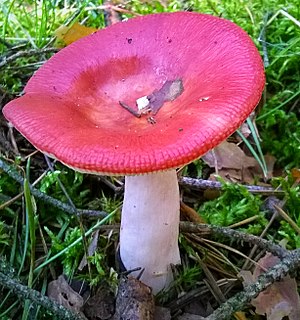
Russula emetica, commonly known as the sickener, emetic russula, or vomiting russula, is a basidiomycete mushroom, and the type species of the genus Russula. It has a red, convex to flat cap up to 8.5 cm (3.3 in) in diameter, with a cuticle that can be peeled off almost to the centre. The gills are white to pale cream, and closely spaced. A smooth white stem measures up to 10.5 cm (4.1 in) long and 2.4 cm (0.9 in) thick. First described in 1774, the mushroom has a wide distribution in the Northern Hemisphere, where it grows on the ground in damp woodlands in a mycorrhizal association with conifers, especially pine.
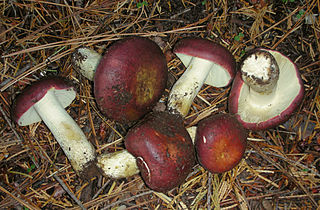
Russula xerampelina, also commonly known as the crab brittlegill or the shrimp mushroom, is a basidiomycete mushroom of the brittlegill genus Russula. Two subspecies are recognised. The fruiting bodies appear in coniferous woodlands in autumn in northern Europe and North America. Their caps are coloured various shades of wine-red, purple to green. Mild tasting and edible, it is one of the most highly regarded brittlegills for the table. It is also notable for smelling of shellfish or crab when fresh.

Russula vesca, known by the common names of bare-toothed Russula or the flirt, is a basidiomycete mushroom of the genus Russula.

Russula ochroleuca is a member of the genus Russula. A group that have become known as brittlegills. It has been commonly known as the common yellow russula for some years, and latterly the ochre brittlegill. It is widespread, and common in mixed woodland.

Russula virescens is a basidiomycete mushroom of the genus Russula, and is commonly known as the green-cracking russula, the quilted green russula, or the green brittlegill. It can be recognized by its distinctive pale green cap that measures up to 15 cm (6 in) in diameter, the surface of which is covered with darker green angular patches. It has crowded white gills, and a firm, white stipe that is up to 8 cm (3 in) tall and 4 cm (1.6 in) thick. Considered to be one of the best edible mushrooms of the genus Russula, it is especially popular in Spain and China. With a taste that is described variously as mild, nutty, fruity, or sweet, it is cooked by grilling, frying, sautéeing, or eaten raw. Mushrooms are rich in carbohydrates and proteins, with a low fat content.

Cortinarius caperatus is an edible mushroom of the genus Cortinarius found in northern regions of Europe and North America. It was known as Rozites caperata for many years before genetic studies revealed that it belonged to the genus Cortinarius. The fruit bodies appear in autumn in coniferous and beech woods as well as heathlands in late summer and autumn. The ochre-coloured cap is up to 10 cm (4 in) across and has a fibrous surface. The clay-colored gills are attached to the stipe under the cap, and the stipe is whitish with a whitish ring. The Latin specific name, caperatus, means wrinkled, and refers to the distinctive texture of the cap. The flesh has a mild smell and flavor.

Russula claroflava, commonly known as the yellow swamp russula or yellow swamp brittlegill, is a basidiomycete mushroom of the genus Russula. It is found in wet places under birch and aspen woodlands across Europe and North America. It has a yellow cap, white gills and stipe and bruises grey. It is mild-tasting and regarded as good to eat.

Russula sanguinaria, commonly known as the bloody brittlegill, is a strikingly coloured mushroom of the genus Russula, which has the common name of brittlegills. It is bright blood-red, inedible, and grows in association with coniferous trees. It was previously widely known as Russula sanguinea.
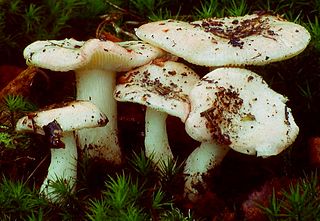
Russula betularum is a small, very pale member of the Russula (brittlegills) genus of mushrooms. It is usually white to very pale pink, inedible, and grows with birch trees. It is commonly known as the birch brittlegill.
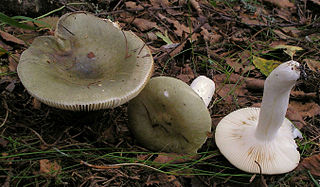
Russula aeruginea, also known as the grass-green russula, the tacky green russula, or the green russula, is an edible Russula mushroom. Widely distributed in northern temperate regions, it is usually found under birch, mostly in pine forests. The very poisonous death cap can have a similar appearance, especially from above.
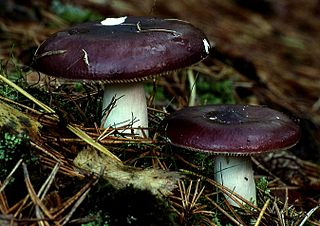
Russula caerulea, commonly known as the humpback brittlegill, is a member of the genus Russula, whose members are also known as brittlegills. It is a dark vinaceous or purple-colored edible mushroom, and grows with coniferous trees in late summer and autumn. It is found in Europe and North America.

Russula atropurpurea is an edible member of the genus Russula. It is dark vinaceous or purple, and grows with deciduous, or occasionally coniferous trees. It is commonly called the blackish purple Russula, or the purple brittlegill.

Russula delica is a mushroom that goes by the common name of milk-white brittlegill, and is a member of the genus Russula, all of which are collectively known as brittlegills. It is mostly white, with ochraceous or brownish cap markings, and a short robust stem. It is edible, but poor in taste, and grows in coniferous, broadleaved, or mixed woods. It can be confused with other white Russula species and certain white Lactarius species.

The inedible wild mushroom Russula fragilis, which goes by the common name of the fragile brittlegill, is a member of the genus Russula, whose members are commonly known as brittlegills. It is a small, fragile, long stemmed, and variably coloured brittlegill, found in mixed forests, and woods in Europe, Asia, and North America.
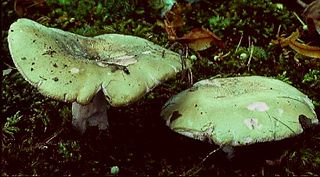
The edible wild mushroom Russula heterophylla, that has lately been given the common name of the greasy green brittlegill is placed in the genus Russula, the members of which are mostly known as brittlegills. It is a variably colored mushroom, found in deciduous forests, and woods in Britain, Europe, and Scandinavia. Appearing with broad-leaved trees in summer to early autumn, it usually has a greenish coloration.

Russula albidula is a species of mushroom in the genus Russula. The species, known in the vernacular as the boring white russula or the whitish brittlegill, is nondescript, with a small or medium dirty white fruit body, and a highly acrid taste. It is found in eastern North America.
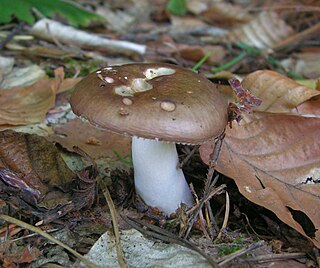
Russula integra, commonly known as the entire russula, is a species of mushroom. One of the huge genus of Russula, it is found in conifer forests across Europe and North America. Mildly flavoured, it is edible and consumed in Central Europe.
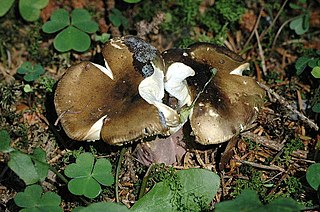
Russula olivacea is an edible and non-poisonous Russula mushroom found mostly in groups from June in deciduous and coniferous forests, mainly under spruce and beech; not rare.

Russula lutea is a common, edible species of mushroom in the genus Russula found throughout the Americas and Europe under broad-leaved trees from summer to early autumn.




















